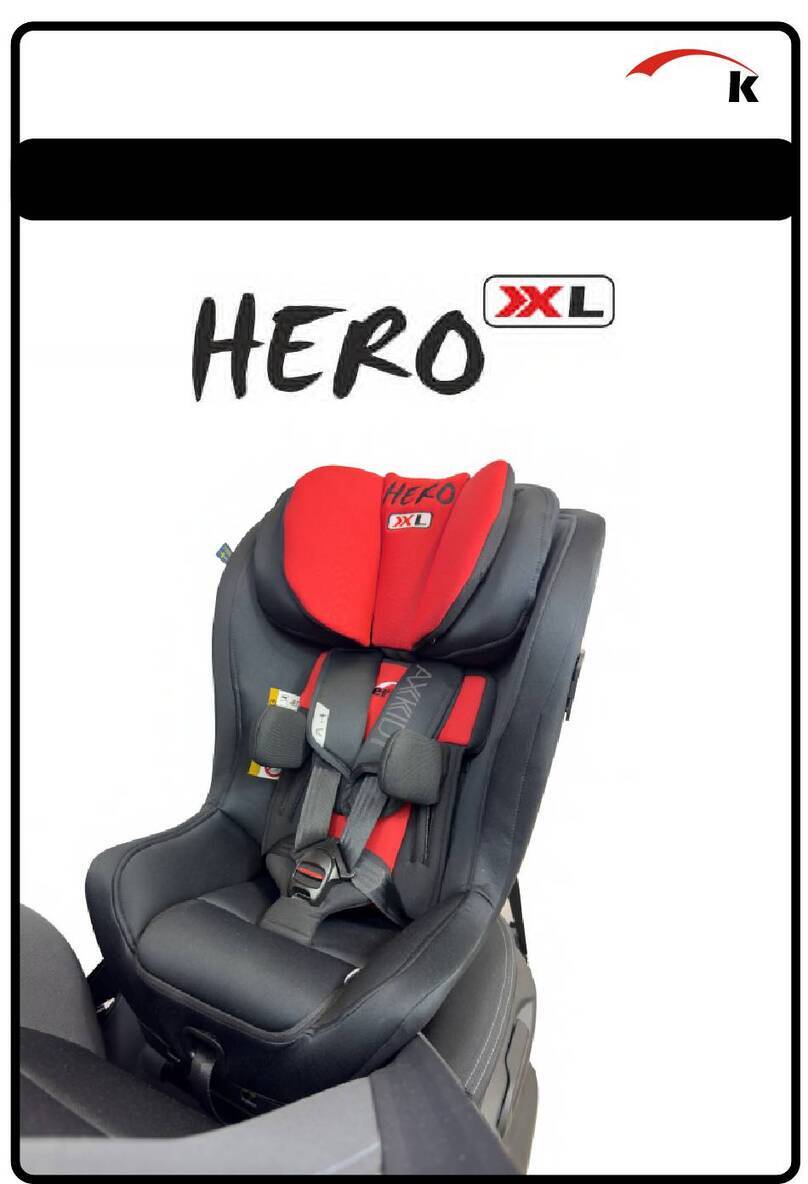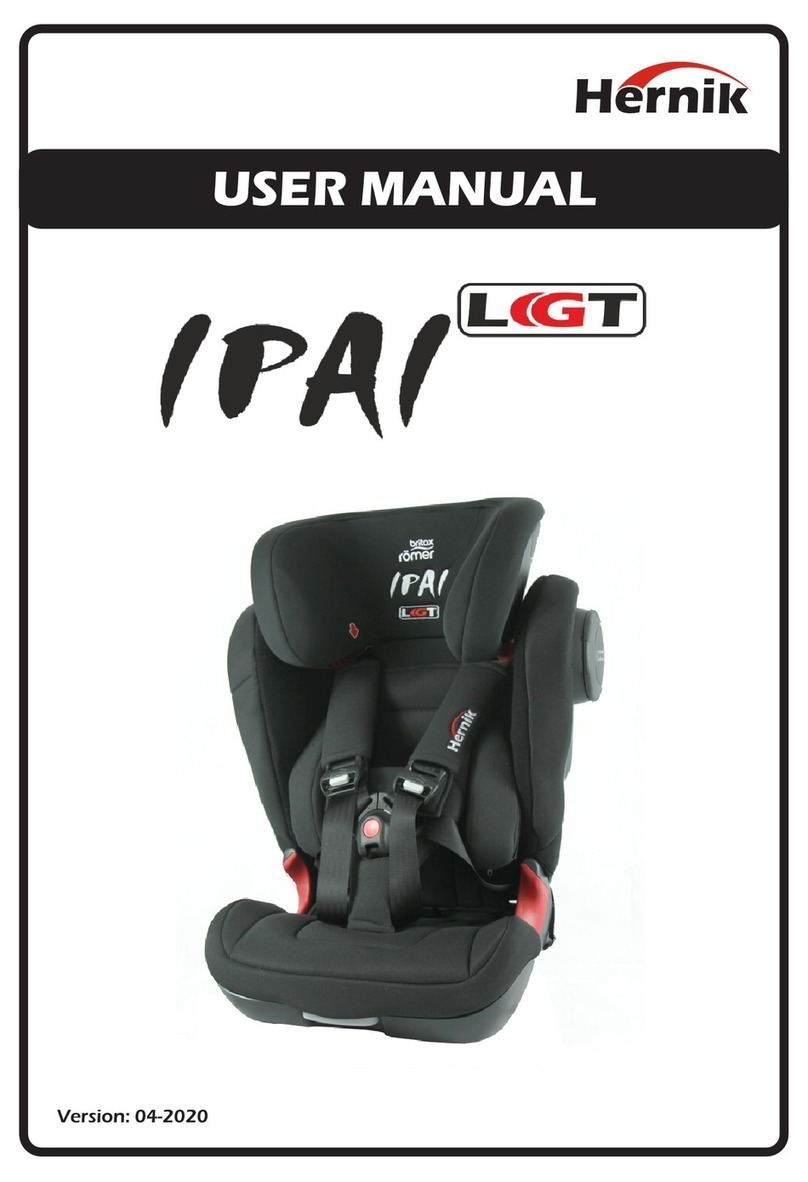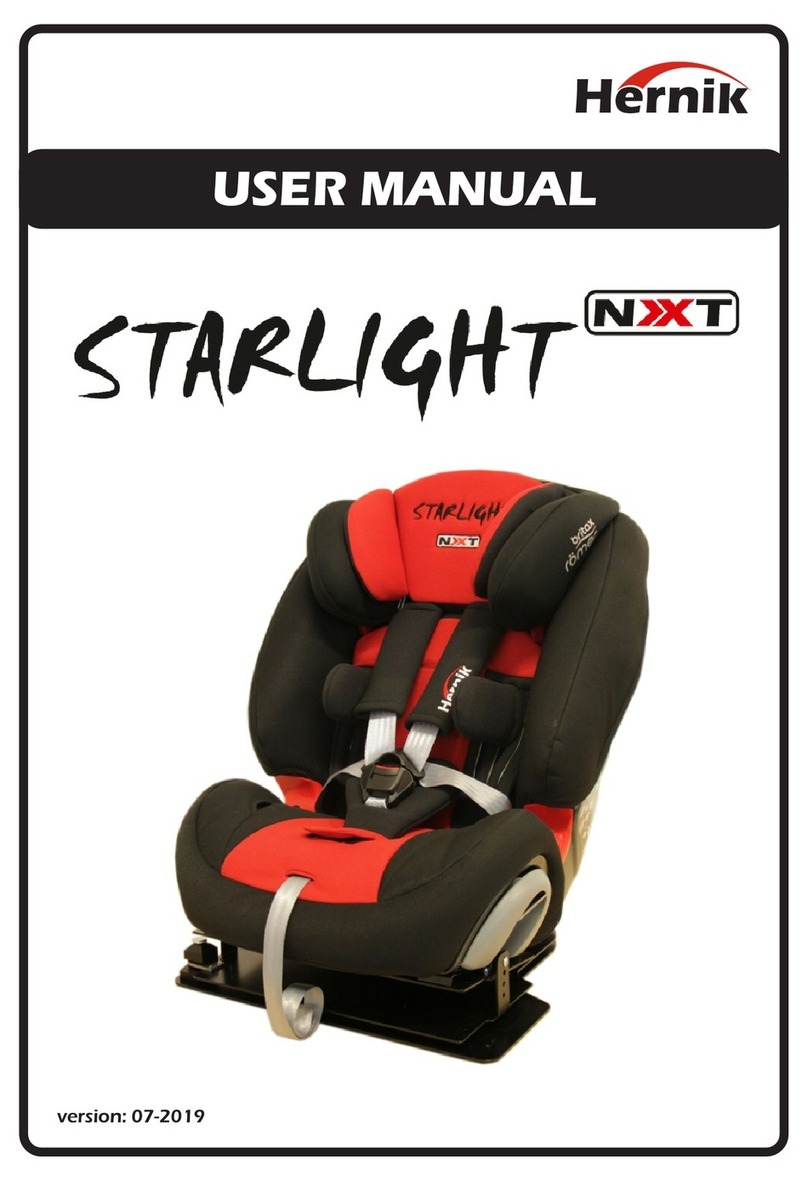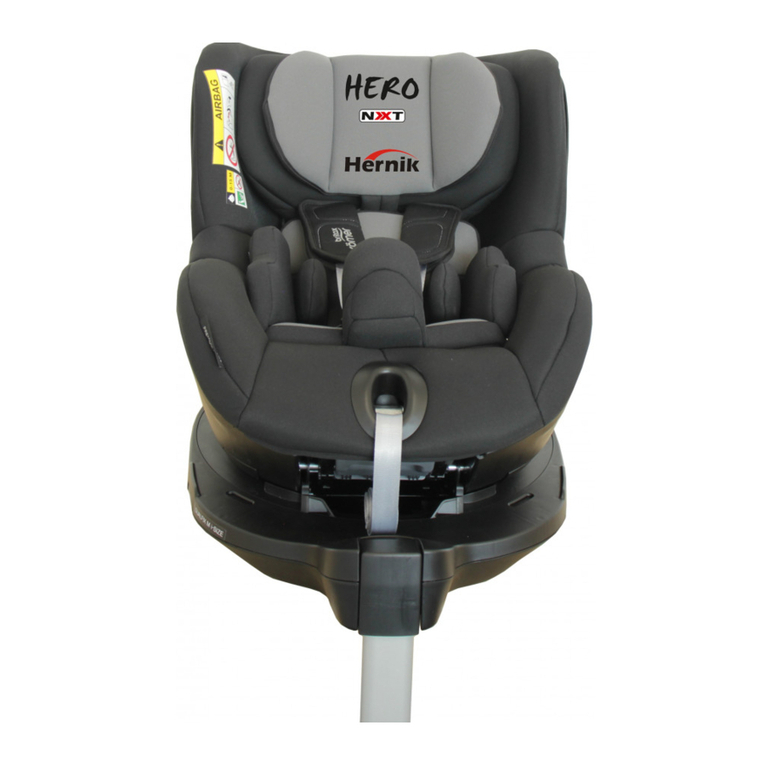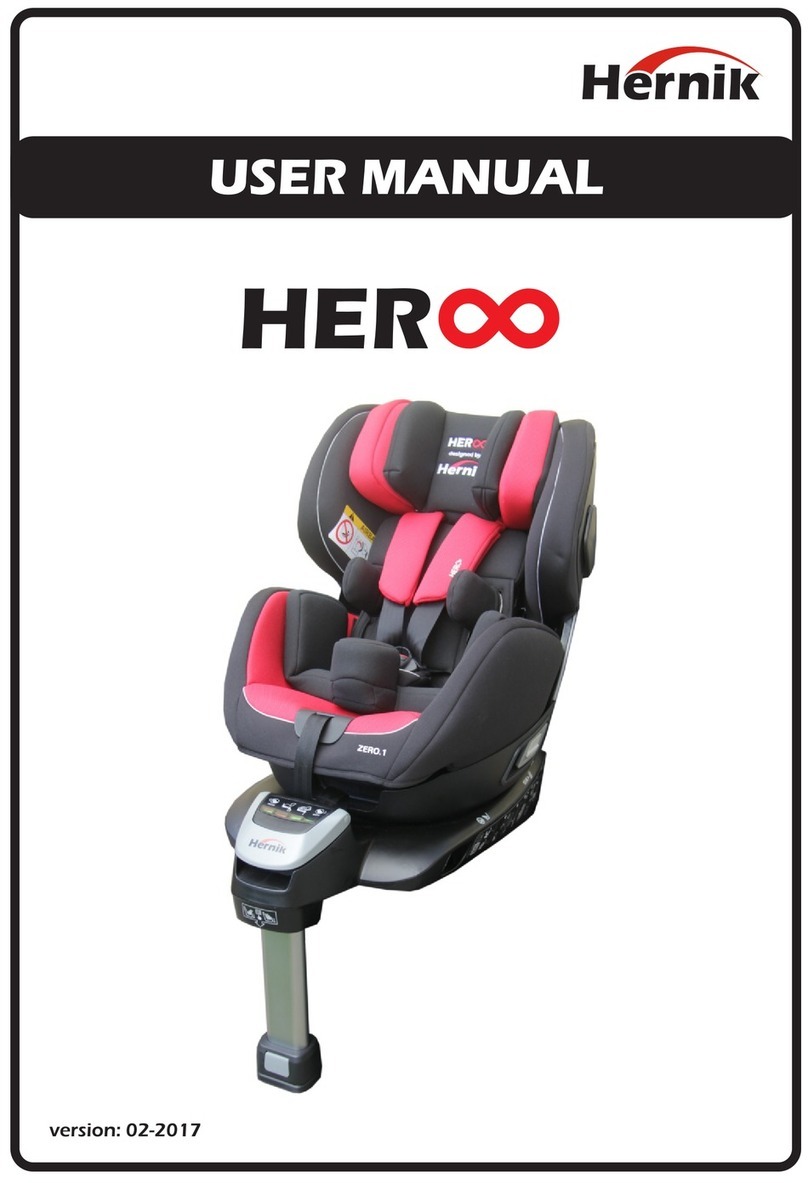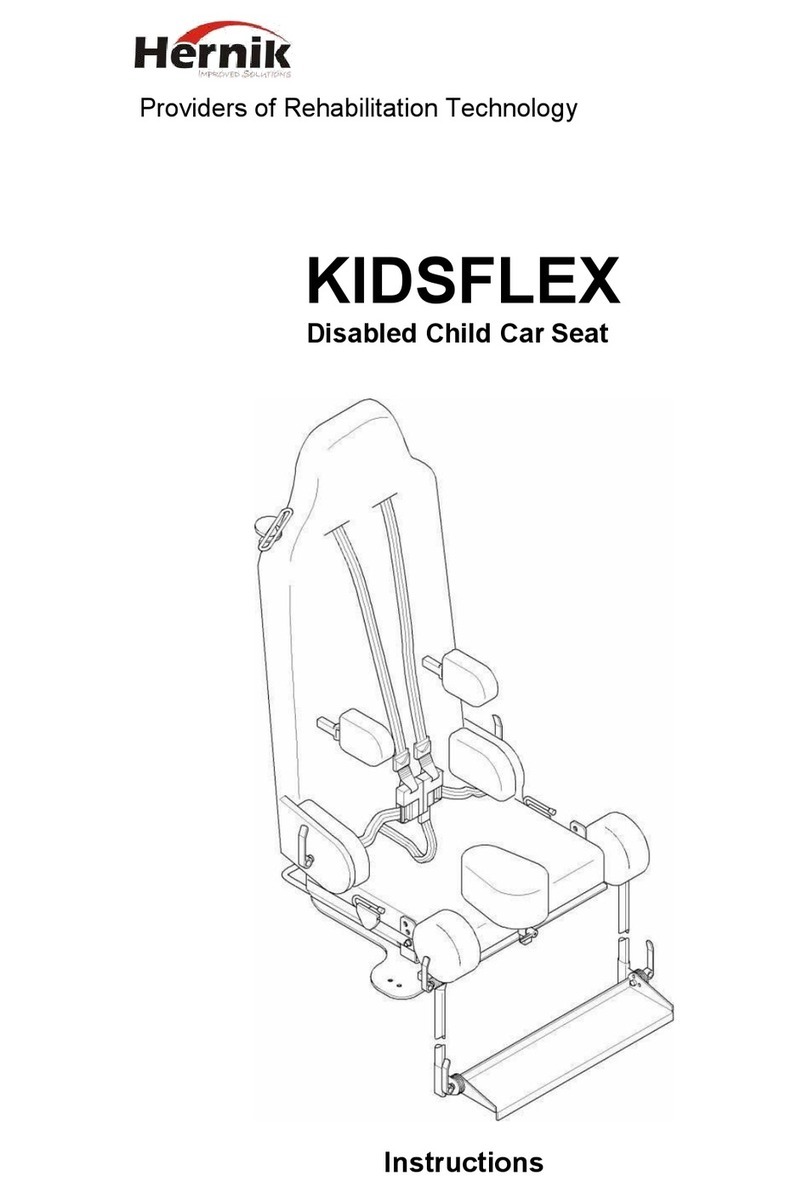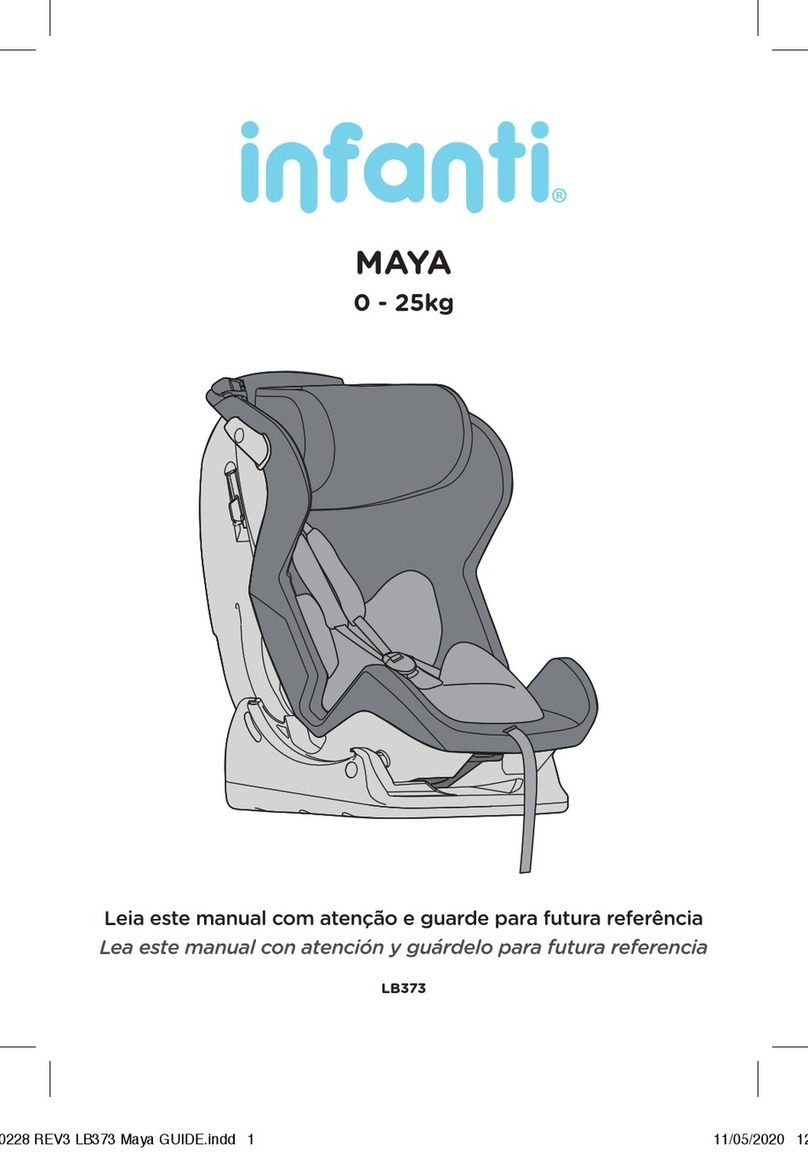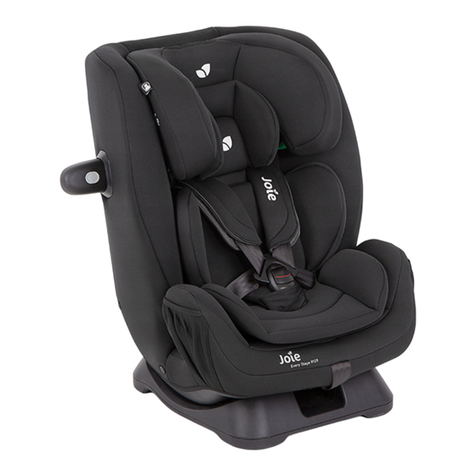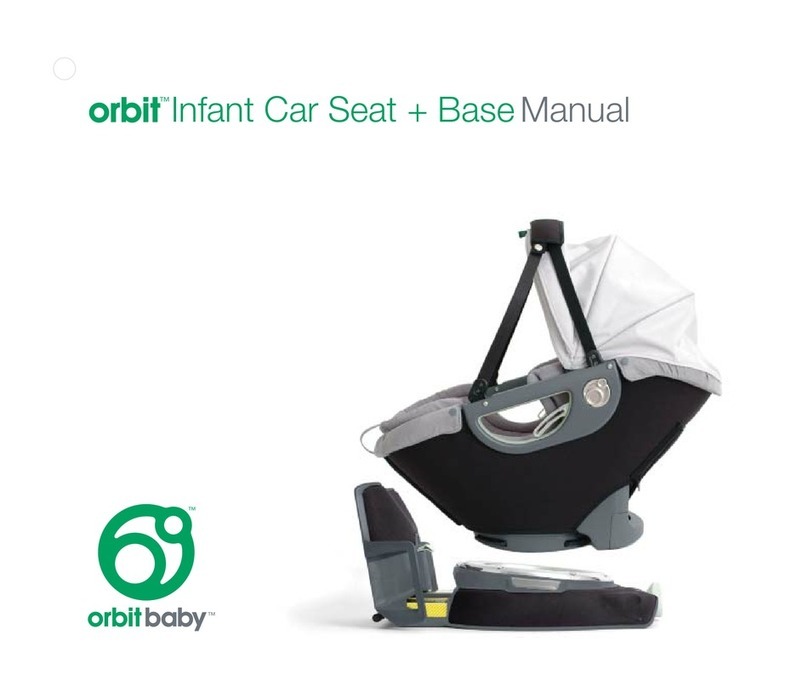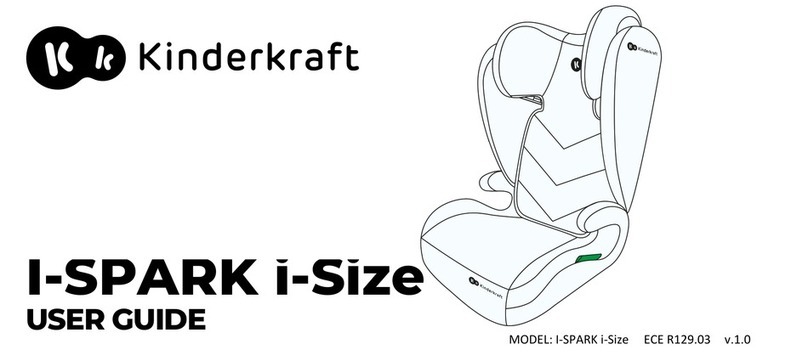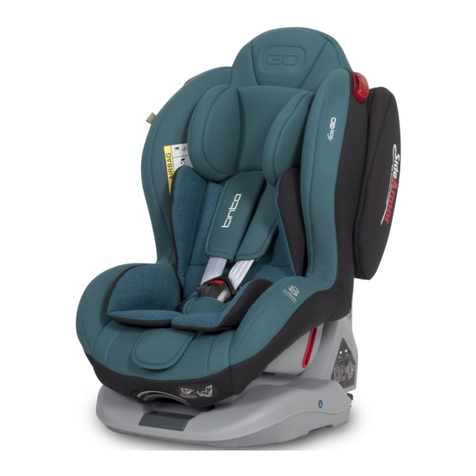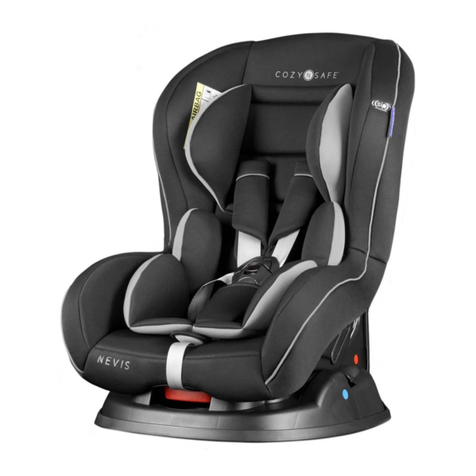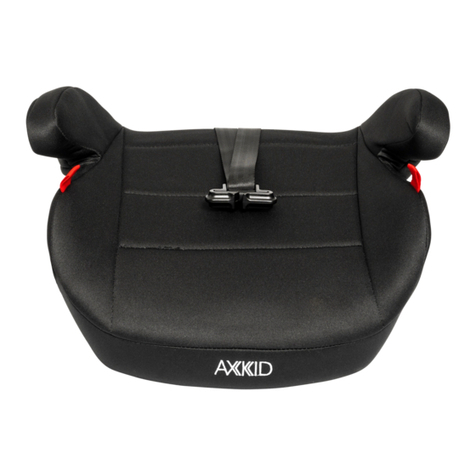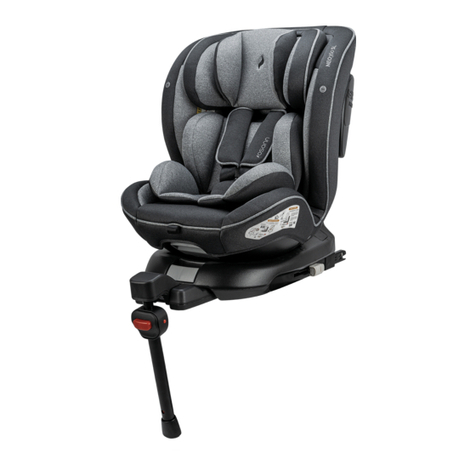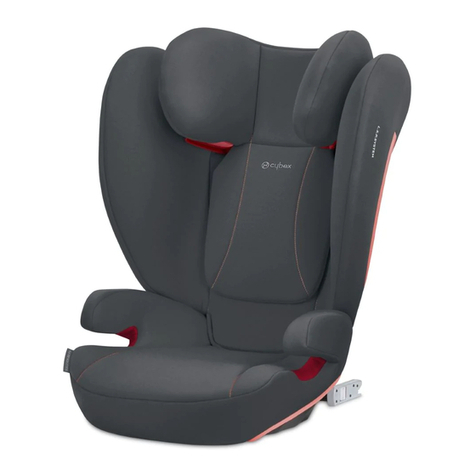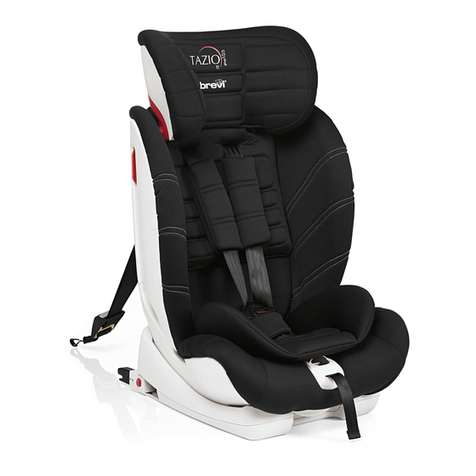Hernik KidsFlex 1 User manual

Serial Number:
User Manual for all Kidsflex Car Seats
Manual: Kidsflex20201105
IMPORTANT CONSUMER INFORMATION NOTICE:
This manual contains important instructions that
must be passed on to the user of this product.
Please do not remove this manual before delivery
to the end user.
SUPPLIER:
This manual must be given to the user of this product.
USER:
Before using this product, read entire manual and save
for future reference.
KidsFlex Car Seat
Installation and
User Manual
Small:
# 4170-0010-020
Medium:
# 4170-0020-060
Large:
# 4170-0030-090

Herni
USER MANUAL
version: 11-2020

Herni
TABLE OF CONTENTS
I. General information Page
1.1 Introduction 2
1.2 Purpose and indication 2
1.3 Relevant information 3
1.4 Declaration of conformity 3
1.5 Warranty 3
1.6 Service and repair 3
1.7 Practical instructions 3
1.8 Installation in the car 4
1.9 Fixing the child in the car seat 4
II. Safety instructions
2.1 Safety instructions 5
III. Handling and functions of the basic seat
3.1 Adjusting the head rest 6
3.2 Adjusting the seat depth 6
3.3 Adjusting the angle of the back 6
3.4 Adjusting the belts 7
3.5 Adjusting the belt guide 7
IV. Using the optional accessories
4.1 ISOFIX-adapter 8
4.2 clamp bow 9
4.3 Security tray 10
4.4 Lateral supports 10
4.5 Abduction block 11
4.6 Angular adjustment 11
4.7 Foot rest / foot roll 12
4.8 Swivel 12
4.9 Protection mat 13
4.10 Belts to connect the chest straps 13
V. Guarantee 14
VI. Labeling 14
VII. Maintenance & product care
7.1 Pull off the cover 15
VIII. Technical characteristics 16
•Page 3 •

Herni
I. General information
1.1 Introduction
You have chosen the car seat „KIDSFLEX“ and get hereby a high quality product
from our house. We would like to thank you for your trust in us.
To make sure you find joy with this product and to ensure it helps you to make
everyday life easier, we present you this manual. It shows you the correct and
simple usage and the necessary care and maintenance. To avoid damage due to
operator error and to ensure best use, please read the following instructions
carefully. If you have any questions or problems, please contact your dealer.
We wish you a trouble-free use and hope that our product meets your
expectations.
We reserve the right to make technical changes to the version described in this
manual.
Before installing in your car and using it for the first time, please read and follow
the installation instructions on pages 4 - 7. Please ensure that the instructions for
use remain with the product and are therefore available to everyone who uses the
seat.
Yours
HERNIK GmbH
1.2 Purpose and indication
The KIDSFLEX was developed for the transport of children with special needs in
cars. Children with poor head or trunk control (eg infantile cerebral palsy, muscular
dystrophy, hypotension) can be supported in their posture by means of
individually positioned thorax pads and special upholstery which ensures a safe
transportation.
Important optional accessories can be used to address specific needs such as: the
seat angle or the installation of a stable abduction wedge or a footstool. More in
chapter IV.
• Page 4 •

Herni
I. General information
1.3 Relevant information
The KIDSFLEX car seat for disabled children is built for use on the back seat of a car
and requires an existing, functioning 3-point seat belt. The seat can be attached
behind the front passenger or behind the driver‘s seat.
In addition to the 3-point seat belt of your car, the car seat is equipped with a 5-
point chest and shoulder belt that offers your child additional support.
1.4 Declaration of conformity
HERNIK GmbH declares in sole responsibility that the car seat "KIDSFLEX" complies
with the Essential Requirements (Appendix 1 of Directive 93/42 EEC). The product
is marked with the CE mark according to the above mentioned directive.
1.5 Warranty
A warranty can only be accepted if the product is used under the specified
conditions and for the intended purposes. The manufacturer is not liable for
damage caused by components and spare parts which were not approved by the
manufacturer.
1.6 Service and repair
Service and repairs on the KIDSLFLEX may only be carried out by specialized
dealers. If you have any problems, contact your local dealer. For repairs you will
only receive original spare parts.
1.7 Practical instructions
The car seat will be delivered fully assembled. Upon delivery, the dealer will instruct
the user how to use the device by using the manual. The specialist dealer should
install together with the user the car seat in the car and if available adjust the Isofix
strap or the clamp.
In order to achieve an optimal sitting position, it is necessary to adjust the car seat
individually to the circumstances of the child. This should always be done by the
dealer.
‚After instruction, the user should carry out all functions as well as installation and
removal of the car seat in the presence of the specialist dealer.
• Page 5 •

1.8 Installation in the car
Place the child seat on the vehicle seat. Make
sure that the backrest lies flat against the
backrest of the vehicle seat.
Tip! If the headrest of the vehicle seat disturbs,
remove it.
1.9 Fixing the child in the car seat
Open the 5-point-belt and
make sure that the straps are exposed.
If a swivel adapter is available, rotate the
car seat. This makes it easier for you to put the
child in the car seat.
Swivel the optional thorax pads out by
pressing the red dots.
Put the child in the car seat.
Close the 5-point belt.
Rotate (if swivel adapter is available)
the car seat back until the locking audibly snaps
into place.
Now thread the 3-point seat belt into the
belt guide and guide the belt through the
open belt guide left/right.
Lay the belt over the child and the car seat
and thread it on the other side left/right through
the second open belt guide . Snap the seat belt
buckle tongue in the car‘s belt buckle.
Make sure that the vehicle belt is not twisted.
Otherwise the full protective effect of the restraint
system is not given.
ATTENTION! Instructions on how to correctly adjust the headrest, the belt guide
and the ISOFIX can be found later in the user manual under point 3.1, 3.4 und 4.1.
Herni
I. General information
• Page 6 •

Herni
II. Safety instructions
· Before use, the components must be checked for perfect function and
condition.
· The instructions for use must always be carried on the child car seat.
· The safety of your child is only guaranteed if the seat is installed correctly and
if the child is fixed exactly.
· The straps must be laid tight and without twisting.
· The 3-point safety belt is to be guided through the provided belt guides and
is supposed to surround the seat tightly.
Please check:
A) whether the seat belt is securely placed in the belt guide
B) whether the belt buckles are locked correctly
C) that no textiles are impacted
· Make sure that no solid objects like pins, belt buckles, etc. are placed between
child and seat belt. This could lead to injuries in the event of accidents.
· Explain to your child how important it is to be well-secured and that the
course of the straps do not change. It shouldn't pull on the straps nor
open the belt buckles.
· Do not make any changes to the car seat, otherwise you risk your child's
safety.
· The car seat must not be damaged by moving parts in the car or through
doors.
· Never leave your child alone in the child car seat.
· Inform your passengers how your child can be taken out of the seat after an
accident.
· After an accident, the entire child car seat has to be renewed.
• Page 7 •

3.1 Adjusting the head rest
Loosen the cap nut on the back plate.
Adjust the headrest to the desired height.
Fix the cap nuts again.
3.2 Adjusting the seat depth
Loose the seat cushion from the Velcro
to get access to the cap nuts .
Open the two cap nuts on the seat
plate.
The position of the seat depth plate can
now be adjusted to the desired seat
depth.
Screw the two cap nuts tight and attach
the seat cushion again with the Velcro.
3.3 Adjusting the angle of the back
Open the two quick release levers on
the left and right of the child car seat.
Put the back plate to the desired angle
and close the levers.
Herni
III. Handling and functions of the basic seat
• Page 8 •

III. Handling and functions of the basic seat
Herni
• Page 9 •
3.3 Adjusting the shoulder and lap belts
Press the red button and pull the lock
parts out of the lock.
The individual parts of the belt must be
exposed.
Put your child in the car seat.
Make sure that your child sits at the very
back of the seat.
Now close the 5-point belt buckle.
Pull the lap belt and both shoulder belts
tight.
Close and open the strap again to check that
the straps are tight.
Correct the belt length if your child is
wearing different clothes.
3.4 Adjusting the belt guide
Loosen the two cap nuts on the back plate
at the front so that the screws can be
opened.
Adjust the belt guide in the grid, so that
you reach the desired position.
Now tighten the screws again and fix the
nuts on the back plate at the front.

4.1 ISOFIX adapter
Installation:
Let the installation of the seat and it‘s adjust-
ment be demonstrated to you by the technici-
an.
Open the setscrews on the left and right and
pull the bracket out to the rear.
Adjust the back rest of the car seat to the requi-
red angle. Slide the ISOFIX adapter on both
sides backwards in the direction of the backrest
until you hear the locking of the two ISOFIX
tongues in the vehicle‘s ISOFIX mounting
(two klicks).
Push the car seat towards the backrest of the
vehicle until both touch and are slightly under
tension. This prevents vibrations while driving.
Close the two setscrews left and right. In
addition, the two ISOFIX tongues must be
protected against unattempt opening, which is
why both screws must be tightened.
Ensure that both ISOFIX tongues are engaged
by a double-sided pulling test.
Removal Note:
Open the two screws
Move them forwards in the direction of the car seat, releasing the grid connection
of the system. It may be necessary to compensate for the pressure of the seats pad-
ding so that the connection can be solved.
The car seat can now be removed from the vehicle.
Herni
IV. Using the optional accessories
• Page 10 •

4.2 Clamp bow
Installation:
Let the installation of the seat and adjust-
ment of it be shown to you during the deliv-
ery.
Open the setscrews on the left and right
and pull the bracket to the rear.
Adjust the back rest of the car‘s seat to the
required angle. Now push the clamp on
both sides backwards in the direction of the
backrest, until it sinks into the gap of the car
seat and seat upholstery and remains firm.
Push the car seat against the backrest of the
vehicle until it rests flat.
Now close the two setscrews left and
right.
ATTENTION! Whether the crank of the bracket
has to be directed upwards or downwoards
depends on the construction of the respective
car seats.
Removal Note:
Pull the car seat indlucding the clamp out of the gap of the car seat.
Herni
IV. Using the optional accessories
• Page 11 •

4.3 Security tray
Installation:
Let the installation of the security tray be
shown to you during the delivery.
Put the security tray on the car seat after
sitting your child into it and strapping it on.
Secure the padding using the supplied Velcro
straps , which are fastened to the back of the
car seat.
Your child's arms should rest on the table,
which leads to an upright seating position. This
supports the upper body.
Make sure that no objects are placed on the
upholstery which could be dangerous during a
braking maneuver.
4.4 Lateral supports
Open the screws of the pads on the back of
the back plate.
Position the pads in the desired slots.
Fix the screws again.
Herni
IV. Using the optional accessories
• Page 12•

Herni
IV. Verwendung des optionalen Zubehörs
4.5 Abduction block
The abduction wedge helps your child to
reach a predetermined distance between the
knees. In order to loosen or tightening the 5-
point belt, the wedge must be removed.
Open the clamp and remove the wedge
upwards.
The wedge should always be used while
driving (if chosen as an option), otherwise
your child could be injured by the bracket.
The lever can be changed in its position by
gently pulling it forward without moving the
screw connection. Make sure it is up and not
out of the way, otherwise your child's calves
may come into contact with it.
4.6 Angular adjustment
If the seat angle provided by the vehicle seat
is insufficient, the seat angle of the car seat
can be increased by the (extended) child seat
angle adjustment. For this purpose, the screw
left and right has to be opened and
another hole to be selected. Then tighten the
screws back.
For safety reasons, no quick release is
possible here!
IV. Using the optional accessories
• Page 13

4.7 Foot rest / foot roll
The tabs are fixed below the seat in the base
mount, using grub screws. This is also, how the
depth can be adjusted.
The inclination of the handrails can be varied
by opening the quick release lever . Please
make sure that the levers are then in a position
that do not lead to injury.
To adjust the height of the footrest, open the
grub screws on the left and right. Now the
height can be changed stepplessly and the
grub screws tightened again.
4.8 Swivel
To facilitate the daily transfer to the vehicle, we
recommend our swivel adapter, which allows
the car seat to swivel outwards by 90°. For
technical reasons, only ONE direction of
rotation is possible. For a later change in the
other direction, the car seat must be converted
by HERNIK or an authorized specialist.
The use of the ISOFIX adapter or clamp bow is
strongly recommended!
To rotate the chair, pull the snapper up and
move the chair at the same time. The optional
footrest remains in place to avoid collisions with
the front passenger seat and the B-pillar. Pay
attention to your child‘s legs as you turn!
After the transfer, simply turn the KIDSFLEX
back to the starting position and pay attention
to the „click“-sound, when the stainless steel
tongue locks in the snapper again.
Herni
IV. Usage of the optional accessories
• Page 14 •

4.9 Protection mat
Position the protection mat on the car seat
without blocking the ISOFIX connectors.
Place the KIDSFLEX in the center of the
protective mat and secure it as described in
chapter 4.1.
4.10 Belts to connect the chest straps
Position the belt at the height of your child‘s
chest. Keep a sufficient distance to the neck!
To prevent the belt from slipping, the inside is
equipped with Velcro. To loosen it, loosen it
with your fingers.
Now adjust the widht of the belt by
threading the belt out of the slider and then
widening the belt lock accordingly.
Now secure the loose end of the belt again
using the slider to prevent the belt from
loosening unintentionally.
Herni
IV. Usage of the optional accessories
• Page 15 •

Herni
V. Guarantee
Hernik products are designed and manufactured in accordance with strict quality
standards. If, in exceptional circumstances, you have cause for complaint, Hernik
GmbH guarantee in accordance with the terms and conditions of delivery:
• 24 months warranty on all solid parts, from date of delivery.
• 12 months warranty on all moving parts, from date of delivery.
For parts that were not manufactured by Hernik GMBH, please refer to the
warranty policy of the respective manufacturer (Römer-Britax Kindersicherheit
GmbH). Claims under this guarantee are subject to the device being properly
installed and used in accordance with the instructions provided.
Warranty is void where modifications or improper repairs, without prior
consultation with the manufacturers are carried out. Warranty is void where a
device is improperly fitted.
Further claims, for whatever legal reason, in particular, claims for direct or indirect
damages are excluded.
On the back you‘ll find the following labeling:
• Page 16 •
VI. Labeling

7.1. Pull off the cover
The cover can be removed and washed with a mild detergent in the fine washing
program of the washing machine (30 °C). Please refer to the instructions of the
washing label of the cover.
The plastic parts can be cleaned with soap and water. Do not use harsh
cleaning material (such as solvents).
DANGER! The child safety seat must not be used without the seat cover.
Remove the headrest (if availale) by loosening the screw.
Now loosen the shoulder straps from the Velcro strip on the inside of the back
plate.
The back cushion can now be removed.
Open the zipper and pull off the covers.
For pulling of the seat cushion, first loosen the belt connection between the
belt lock and the seat plate.
Remove the seat plate, open the zipper and pull off the covers.
Herni
VII. Maintenance & product care
• Page 17 •

Herni
• Page 18 •
Standard equipment:
• 5-point-harness with impact pad and shoulder padding
• integrated headrest
• adjustable seat depth
• three-part basic cover, removable and washable at 30 °C
• belt guide (assembled on the right or left)
• stepless back angle adjustment
• Base frame to accomodate a footrest, a clamp bow or Isofix adapter
VIII. Technical characteristics

Herni
• Seite 13 •
HERNIK GmbH
Auf der Gröb 2c
83064 Raubling • Germany
+49 8035-9580448 • +49 8035-9580446
[email protected] • www.hernik.de

New Zealand Head Office
22 Detroit Drive,
Rolleston 7675
Call 0800 543 343
Australian Head Office
26 Pardoe Street,
East Devonport, TAS 7310
Call 1300 543 343
www.medifab.com
Your enthusiastic distributor is
This manual suits for next models
5
Table of contents
Other Hernik Car Seat manuals
